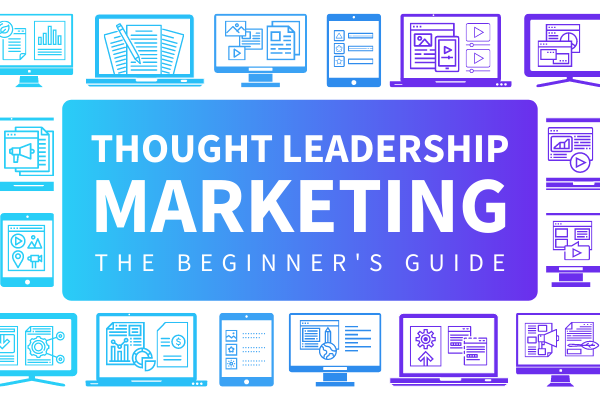Although it’s not a new term, now more than ever, business leaders are branding themselves as “thought leaders” for a number of reasons. For one thing, the label “thought leader” conveys an added level of expertise and authority for them, personally, as a representative of their company. For another, the practice of thought leadership marketing does the same for their brand as a whole. This allows them not only to outshine competitors but also attract potential customers simply through content. What’s not to love about that?
Knowing these benefits, this blog is all about how you can build a thought leadership marketing strategy of your own. Whether you’re running a small or large company, building a tight-knit or extensive team, the benefits of building your authority are clear. Plus, providing high-quality content is a proven way to broaden your brand’s exposure. That way, over time, you can worry less about chasing leads and focus more on incoming ones.
Before we begin, keep in mind that this article is largely focused on the marketing aspects of an expert business. For more information about complementary sales and operational strategies, check out our previous guide, “Thought Leadership 101.” 👍
What is thought leadership marketing?
First and foremost, let’s start with the definition of thought leadership marketing. At its core, thought leadership marketing is about creating content for your audience in order to provide value. This includes blogs, videos, downloadable resources – anything that meets a need for your target audience and provides insights that lead them to a solution for their problem(s).
In short, thought leadership marketing takes a personal approach to the idea of “inbound marketing” popularized by HubSpot. As they describe it, “Inbound marketing is a business methodology that attracts customers by creating valuable content and experiences tailored to them. While outbound marketing interrupts your audience with content they don’t always want, inbound marketing forms connections they are looking for and solves problems they already have.”
Likewise, thought leadership marketing uses content creation to attract an audience by addressing their questions or concerns. Over time, this approach allows you to build authority and trust within that audience. It also keeps you top-of-mind so that, when they’re in the market for one of your products or services, you’re the first name that pops into their mind.
How is thought leadership marketing different from content marketing?
Speaking of content, another term commonly used in marketing is “content marketing,” leading many to ask, “What is the difference between thought leadership and content marketing?” In a nutshell, content marketing encompasses all content creation efforts that aim to attract customers. However, thought leadership marketing applies an additional layer of strategy centered around pushing the audience’s boundaries.
For example, every week, SpeakerFlow releases a new blog post related to an expert business. In many cases, they focus on frequently asked questions or common problems, and, if they were the only content we released, we could only call ourselves “content creators.” Instead, because we also release content arguing against established industry standards and or sharing our original research, we’re considered thought leaders.
Put simply, because our content strives to share new insights and be on the cutting edge, we’re leading our audience (if that’s not tooting our own horn too much to say 🥳 ). In your own business, the same applies, and managing a thought leadership marketing strategy is first about leading. Whether your audience is facing industry-wide changes or global problems, like the coronavirus pandemic, you become a thought leader when you consistently provide value for them and share content that empowers them to create a better, more successful future of their own.
What are the benefits of thought leadership marketing?
At this point, you might be wondering, “That’s great for my audience, but how does thought leadership marketing benefit me?” As mentioned at the beginning, there are dozens of answers to this question. But, most importantly, implementing a consistent thought leadership marketing strategy means more attention and – by extension – more clients or customers for your business. Below, we’ll cover four additional benefits and how they tie into this central gain.
Greater Visibility For Your Brand
The first benefit of thought leadership marketing is greater brand recognition and visibility. Because it’s inherently about sharing new ideas, thought leadership marketing is almost guaranteed to attract attention, good and bad. In fact, according to a 2020 study, 88% of consumers cite well-executed thought leadership as the reason for their positive connotation with an organization. Another 60% even went so far as to say that thought leadership content has prompted their purchasing decisions.
We’ll talk more about the monetary benefits of thought leadership marketing shortly. But, the bottom line is that it generally makes your brand more visible which, in turn, makes potential customers more likely to follow you and remember your name when they’re ready to make a purchase. It also engages existing customers, making them more likely to pay attention and stick around. Win, win!
Greater Authority In Your Niche
Similarly, another benefit of thought leadership marketing is an elevated level of authority in your target market. While some forms of content – like blogs or podcasts – may seem less important than books or coursework when it comes to building influence, the truth is that all forms of content can add to your potential and existing customers’ perception of you and fuel your sales efforts.
For example, one of today’s most well-known marketing thought leaders is Neil Patel. As a blogger and podcaster, Patel is known for his no-nonsense, action-oriented content. But, from a sales standpoint, he’s also the owner of Ubersuggest, an search engine optimization (SEO) tool designed to make keyword research simple. By investing in his thought leadership content, Patel pulls these pieces together, building his authority to the point that, when he recommends Ubersuggest in a blog or podcast, his audience takes his word as gold and signs up on a paid plan.
With your own business, building your authority through thought leadership creates the same opportunity. Content builds authority and attracts attention, which drives lead generation and revenue – plain and simple.
Increasing Numbers Of Incoming Leads
On the subject of leads, the third benefit of thought leadership marketing is a greater number of incoming leads, or potential customers that initiate contact with you rather than the other way around. Compared to building your visibility or authority, creating lead generation mechanisms can be a long-winded process, and, for many businesses, it takes years before they can consistently correlate their marketing efforts to income.
That said, because thought leadership marketing, specifically, is focused primarily on providing value, this jump from “interested” to “invested” can happen much more quickly. SpeakerFlow, for instance, was only founded in 2019, marking it a relatively new business in the expert business market. Among our own customers, however, we’re already able to attribute 75% of our sales to our marketing touchpoints. And, this year alone, we’ve gone from less than 3,000 daily impressions of our website to more than 30,000. That’s a huge spike, largely fueled by content production!
In the same way, a thought leadership marketing strategy in your business is, by definition, playing the “long game.” But that length gets shorter and shorter the more content you create and the more valuable it is. Plus, all of that progress can be directly associated with revenue.
Reduced Dependence On Outbound Sales & Referrals
The fourth and final benefit of thought leadership marketing we’ll cover here is a decreased dependence on traditional lead sources. For many new businesses, it can be tempting to conduct as much outreach as possible. Cold calls, for example, are a well-known strategy to connect with potential customers. Other examples include in-person networking for local businesses or cold emails.
Conversely, well-established businesses can develop the opposite problem and rely too heavily on their existing customer base. Among professional speakers, for instance, it’s common practice to cite referrals as the primary source of yearly income.
On both of these ends of the sales spectrum, the problem comes when those lead sources dry up. When a once-in-a-lifetime pandemic happens, when your local economy crashes – you name it – chasing leads isn’t going to work, and you won’t necessarily be able to assume you’ll get referrals each month. If you’re focused on providing value and sharing high-quality content, however, you’ll be good to go. Even when dramatic changes happen in your life or your business, the integrity of your thought leadership marketing will be consistent. Therefore, your lead flow will be consistent, too. Sounds like a dream, right?
How do I build a thought leadership marketing strategy?
Now that you know the benefits of a solid thought leadership marketing strategy, let’s dive into the details. Depending on your focus audience, there may be unique steps you can take to stand out from other content creators. For instance, if you’re in an industry that doesn’t have a lot of podcasts, you might consider starting one to set yourself apart from the norm. Regardless, whatever your plans and wherever your focus, there are five initial steps that are “tried and true” across disciplines. Below, we’ll cover each of these steps in more detail so you can get started.
Define Your Ideal Audience

Step #1 of a good thought leadership marketing strategy is defining who you serve and how you serve them, or creating “buyer personas.” If you haven’t heard the term before, buyer personas are essentially detailed profiles of the “types” of people that you serve, based on data from previous or ideal customers. They include demographic information (age, geographic location, etc.), what they’re looking for when they make a purchase, and where they are actively searching for solutions to their problems.
To create your own buyer personas, ask yourself the following questions:
- What is their age range and gender, and where do they live?
- What is their professional background, level of education, and income bracket?
- When it comes to sales, what motivates them to make a purchase or reach out for more information?
- What challenges are they facing, and what do they look for to overcome them?
- What goals are they pursuing, and how do those goals tie into the products or services you offer?
- Are there any personality traits to note (introvert vs extrovert, for example)?
Answering these questions may seem tedious, and, truthfully, some may not be relevant to your business. However, in the long run, building buyer personas and identifying the different groups of people you serve allows you to tailor your thought leadership marketing to them, making it all the more impactful. For more information about creating personas, HubSpot’s beginner’s guide to creating them is an excellent resource.
Research Your Competition
Next, when you build any marketing plans – but especially ones related to thought leadership marketing – make sure to study who you’re up against. Although your primary goal is to serve your potential and current clients, your secondary goal is to provide better content than others in your industry and, in doing so, intercept their audience’s attention, too.
Considering your competitors, first look for the types of content they’re sharing. Are they focusing mainly on blogs, podcasts, or videos? Are they embedding different types of content within their posts (i.e. multichannel marketing)? Do they publish one type more consistently than another, and have they recently launched a new content channel?
After that, look at where your competitors are sharing their content. Do they use social media? Email marketing? External content platforms like Medium? One trick many marketers recommend is signing up for your competitor’s marketing channels (subscribe to their newsletter, for instance). That way, you can track their actions as they send you updates and learn from their wins (and losses, for that matter).
Build A Thorough Content Strategy

After looking at your competitors’ content and their strategies, implement a content strategy of your own. To do this, we recommend creating a content calendar using a project management system, like Asana. Like a CRM helps you organize your sales processes, a project management app can help you organize your content plans, from upcoming blog posts to videos you want to share on social media.
Whichever types of content you choose to create, the most important thing to remember is to be consistent both in the quality of your posts and how frequently you release them. In both of these areas, developing a routine shows your audience that they can expect value from you and rely on you for up-to-date information, again, adding to your authority among members of that audience and making them more likely to purchase your sales offerings.
As a side note, content also plays a key role in many thought leaders’ long-term goal of paid speaking. If this sounds like you, rest assured that every piece of your content isn’t just for your audience. It’s for event organizers, too, and the time you invest into high-quality content will pay off in paid speaking engagements in addition to other product or service purchases.
Publish A Variety Of Content (And Across Platforms)
When publishing content, another key to a successful thought leadership marketing strategy is more and more diverse content over time. Although you should ideally start with content areas already popular in your target market, broadening your range of content increases your chances of getting in front of potential customers. It also shows that you’re always improving, as you’re not simply settling for one type of content. You’re adding more and persistently working to stay on the cutting edge of marketing.
With this in mind, there’s a huge variety of content categories for you to choose from. The following are a few of the most popular (aside from books and videos).
- Blogs: Digital articles that focus on one central topic and generally focus on a keyword or phrase; generally less than 10,000 words although can be more; most common length is about 2,000 words broken into shorter subsections
- eBooks: Essentially downloadable PDF versions of a blog; usually focused around an idea (sometimes even a specific keyword or phrase); often used as “lead magnets” as a reader can be asked to enter their email in order to download the eBook; tend to be less than 50 pages
- Podcasts: Audio-only explanations of a keyword or phrase; often conducted as discussions or interviews; episodes usually between 30 minutes and an hour-long
Ultimately, it’s okay to start small. Maybe you’re managing a small team but don’t have the resources to launch a podcast on top of your existing blogs and videos. Maybe you’re a solopreneur, and a blog is all you can manage for the time being. Either way, no matter how you choose to start, the goal is to maintain a growth mindset and expand your content creation efforts when possible.
Authentically Engage On Social Media

In addition to creating and sharing content, another place to build your thought leadership marketing strategy is social media. Today, in the U.S. alone, more than 70% of people use social media for a variety of reasons. These include connecting with friends and family, following news stories from around the world, and sharing ideas with their network. More importantly in this context, however, many users also use social media to follow the brands – personal or corporate – they regularly patronize. So, if you want to become a thought leader and promote the content that explains said thoughts, engaging with your audience on social platforms is a vital step.
If you’re unsure where to start your social media strategy or if you already have one but want to better prioritize your engagement efforts, your first job is to find out where your audience is already active. In SpeakerFlow’s niche, for example, most of our audience uses Facebook and Instagram, so we started our engagement efforts there.
After you’ve identified audience activity, start posting regularly on your social profiles. Your posts can share your other content, they can be videos unqiue to your social profiles (like Facebook live videos, for example), or they can share other resources from within your industry. In any case, just like creating content from the last section, your social media posts should be consistent. They can also be less formal than your other content, allowing you to share your thought leadership with your authentic voice and avoid seeming overly promotional.
How do I write good thought leadership content?
By now, we’ve covered most of the “wins” of thought leadership marketing. All that’s left to do is talk about content, specifically, and what you can do to make your content great. In the broadest sense, the best content marketing incorporates strategies that both get said content in front of more people and provide value so those people can put words into action. To meet these two overarching goals, there are five things you should do above all else. Below, you’ll find each of them along with additional resources to help you kick off a killer content strategy in no time.
Conduct Keyword Research

Step #1 to high-quality thought leadership marketing content is doing your homework ahead of time. Just like planning ahead for a dinner, extensive content planning ensures you’ll be able to execute the related tasks on time and that the end product will be of exceptional value to your readers. It’s also important to remember that content creation should never be aimless or based on your own desires. Instead, it should be designed for your audience from the very beginning.
This means considering what members of your audience are looking for right now. What questions are they asking? Which topics are they searching for most? What areas of your expertise overlap with these inquiries? These are just a few of the questions to keep in mind as you choose the topics – or, in technical terms, the keywords or phrases – for your content.
Additionally, if you’re unsure where to start, look to your competitors for this, too! Chances are, if your competition is writing content around a certain keyword, it’s applicable for your audience as well and you may even be able to outrank them. To get started and learn more about the keyword research process, visit the resources below.
Additional Resources:
- Top Recommendation: “Keyword Research: The Definitive Guide” from Backlinko
- “How to Do Keyword Research for SEO” from HubSpot
- “How to Do Keyword Research for SEO” from Ahrefs
- “Keyword Research: How to Do It, Tips, Tools & Examples” from Neil Patel
- “Keyword Research For Seo: The Ultimate Guide” from Yoast
SEO Optimize Everything
After defining the keywords on which you want to focus, the next step to high-quality thought leadership marketing content is search engine optimization, or SEO. If you aren’t already familiar with it, SEO is essentially structuring your content in a way that makes it easily accessible via search engines, Google in particular. This includes how you tag the headers in your blogs, how you craft the title and meta description of your posts, and the language you use in every piece of content you share.
In the most basic sense, SEO is about choosing a keyword or phrase, then strategically crafting your article, video, or other content work around it to make it readily available for anyone searching that keyword. For example, in our previous blog, “The Ultimate Survival Guide To Professional Speaking,” our keyword was “professional speaking.” So, we used that keyword in the title, applicable headings, and about 1.5% of the body text. This (among other strategies we implemented in the background) makes it SEO-optimized for that keyword.
Likewise, every bit of copy – from your blogs to the descriptions in your podcasts and videos – can and should be SEO optimized for keywords relevant to your audience if you want them to actively follow you and share your content with others. For more information about SEO optimization, check out the resources below.
Additional Resources:
- Top Recommendation: “Search Engine Optimization (SEO) Starter Guide” from Google Business
- “SEO Basics: Beginner’s Guide to SEO Success” from Ahrefs
- “SEO Fundamentals” from Backlinko
- “The Ultimate Guide To Content SEO” from Yoast
- “Blog SEO: How to Search Engine Optimize Your Blog Content” from HubSpot
Incorporate Visual Aids

Step #3 to high-quality thought leadership marketing content is my personal favorite: adding visual aids. While it’s no secret that images or animations make any presentation more interesting, adding them to your content provides a long list of benefits for your audience that then flow back to benefit you. For example, one of the biggest benefits of visual aids is increased reading comprehension, which makes the reader more likely to understand and remember you, which makes them more likely to share the content or even hire you later on.
In other words, adding visual aids is a bit of a long game. But, it’s guaranteed to pay off in terms of engagement. Plus, it’s yet another way to set yourself apart from other content creators in your niche. Hard to say “no” to that, right?
Ultimately, the visual aids best suited to your content will vary depending on your brand style, the length and format of your content, and the preferences of your audience. As a graphic designer myself, I always recommend keeping it simple and, when in doubt, doing your best to choose images or graphics that aren’t too distracting. For more recommendations – and my favorite sources for free images and graphics – see the links below.
Additional Resources:
- Free Images: Unsplash, Pexels, Burst, and Pixabay
- Free Graphics: unDraw and Flaticon
- “How To Make The Best Blog Graphics (For Non-Designers)” from CoSchedule
- “How To Create Graphics For Your Blog” from ConvertKit
- “Blog Image 101 – The Most Effective Image Tips To Help Your Post Stand Out” from DesignWizard
Post Where Your Audience Is Already Active
Once you finish a new content item, your next step is to post it where your audience is already active. This should include social channels such as Instagram, Facebook, LinkedIn, and Twitter. However, you can also incorporate trending channels to engage audience members where your competitors may be missing out. In recent years, for example, many thought leaders have added TikTok to their strategies in order to engage younger audience members.
More importantly, though, all of your content should also link to your website in one way or another. Blogs, for instance, should post directly to your website and link to other pages on your site. Other forms of content, like videos or podcast episodes, can be embedded directly into a blog post so readers can toggle between content formats without leaving the page.
Long story short, creating content is ultimately about providing value in a way that also generates business. If you continually direct people to your website – and the product or service pages on it – you’ll be better able to meet these goals and build your brand recognition in the process.
Track & Follow Your Content Metrics
Last but not least, the most important (and never ending) key to high-quality thought leadership marketing content is data. For many of the aforementioned steps, we’ve touched on learning as you. Where is your audience active, for example? What types of content do they read the most? Which content types do they share, and where do they share it? What keywords are attracting the most attention and bringing the most traffic to your website?
None of these are quick and easy questions, and answering them is an ever-evolving process. Moving forward, the best you can do is monitor your content efforts and collect data wherever possible. That way, you can adjust based on cold hard facts and just go with the flow your audience wants, sharing your insights along the way.
Hopefully, as you launch – or continue to build – your thought leadership marketing strategy in the future, this guide helps you avoid the most common pitfalls. For more information about running an expert business, check out our podcast, Technically Speaking. With weekly episodes, hosting thought leaders from around the world, your next dose of inspiration is just a click away. 👍






